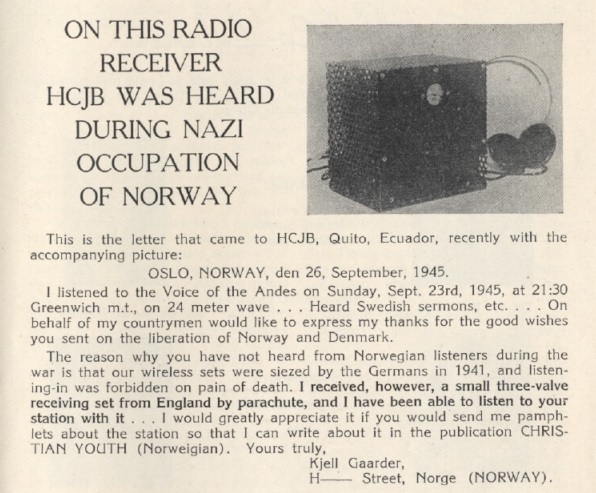The 1945 issue of Radio Missionary Log, the program guide for HCJB, Quito, Ecuador, carried this letter and photo which the station had received after the war. The writer, Kjell Gaarder of Norway, wrote that he had received HCJB on the receiver shown.
HCJB did not carry a Norwegian broadcast, but Mr. Gaarder listened to the station’s Swedish broadcast. He noted that there probably hadn’t been many reports from Norwegian listeners during the war, since the Nazis had seized all radio receivers in 1941, and prohibited listening on pain of death. But Mr. Gaarder reported that he “received, however, a small three-valve receiving set from England by parachute,” and had listened to HCJB with it.
According to the program guide, HCJB was broadcasting in Swedish ninety minutes per week, from 4:30-5:00 PM U.S. Eastern Standard Time (the same as local time in Quito) on Sunday, Tuesday, and Thursday. The broadcasts were on 12.5 MHz, the station’s main frequency, with 10,000 Watts. The Swedish broadcast would have also gone out with 1000 watts on 9.9 and 6.2 MHz.
Curiously, the book The Portable Radio in American Life mentions an RCA engineer named Kjell Gaarder, who made some adjustments to a small radio in 1940 to make it smaller. It seems inconceivable that two small radios in different parts of the world just happened to have a connection to someone with the same unusual name. It seems almost certain that the RCA engineer in America in 1940 was one and the same as the person who just happened to receive a radio delivered by parachute a few years later.
I suspect that Mr. Gaarder returned to Norway during the Nazi occupation, and probably participated in the resistance, as evidenced by his British radio. There must be an interesting story here, and I hope some reader can give me some clues as to that story.

